#Camel Wool
Explore tagged Tumblr posts
Text
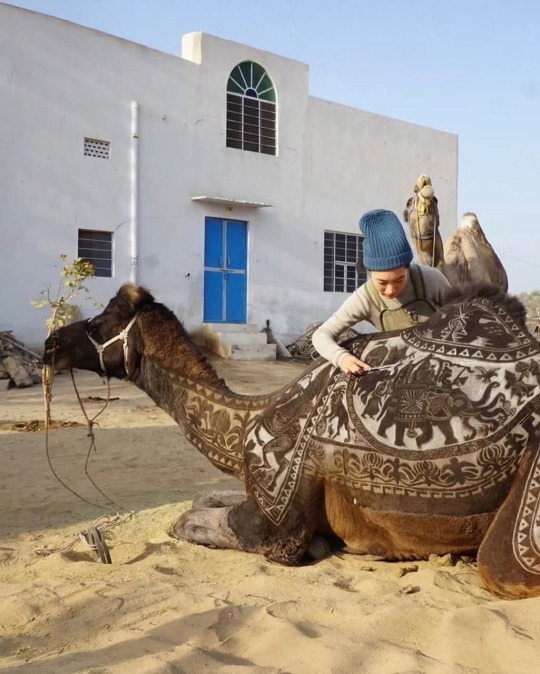
Wool carving is a centuries-old tradition and art in Pakistan and India
An art that requires not only a high level of professionalism and certain skills, but also endless patience, consists of the filigree shearing of camels with the creation of stunning ornaments.
Camels are sheared using a special technique and the entire process takes about three years. The first two years, while the camel's hair grows, it is only trimmed and prepared. In the third year, when the hair reaches the desired length, it is carefully cut in the form of various ornaments on the back, sides and neck of the camel, and only by hand, with ordinary scissors.
94 notes
·
View notes
Text






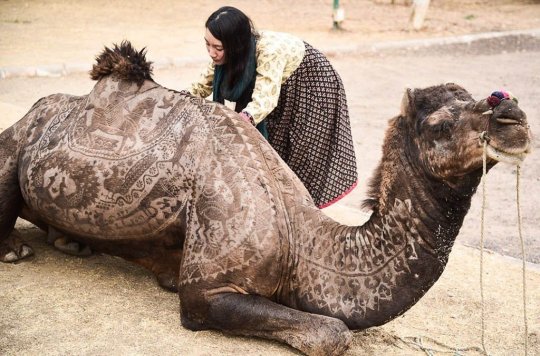




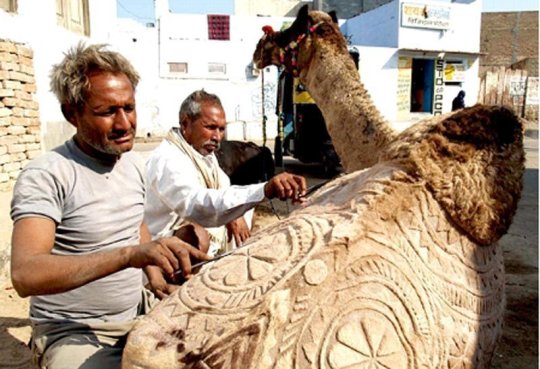




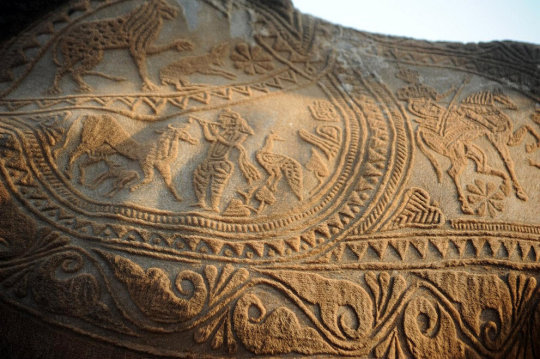
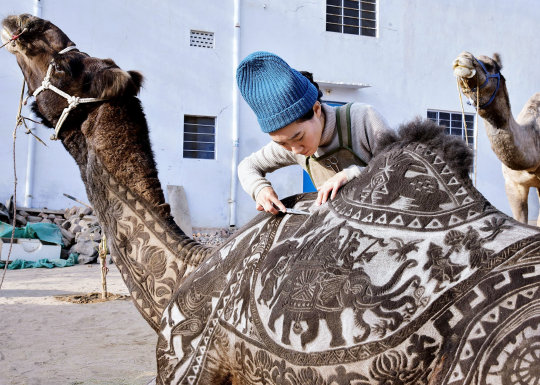
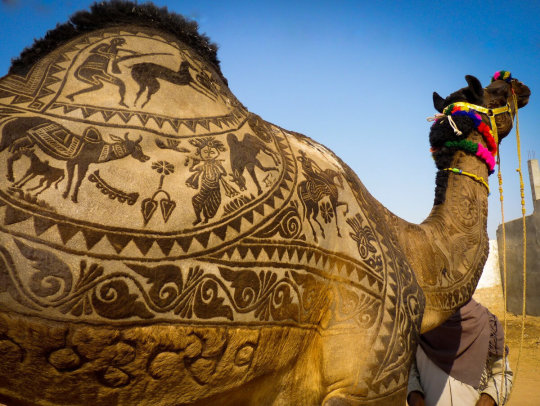

В Индии фестиваль верблюдов – одно из самых красивых и запоминающихся событий в стране. Проходит фестиваль в индийском городе Биканер в штате Раджастан. Биканер находится в пустыне Тар и знаменит тем, что именно в нем расположена единственная в Индии ферма верблюдов.
Изюминка этого праздника - оригинальный верблюжий карвинг. Карвинг по шерсти (так называется художественная стрижка верблюдов) - это искусство, которое требует не только высокого уровня профессионализма и определенных навыков, но и нескончаемого терпения. Верблюдов стригут особым образом, создавая на теле изысканные узоры. На создание такой оригинальной прически хозяину животного нужно около трех лет. Первые два года, пока шерсть верблюда отрастает, ее только подравнивают и подготавливают. А на третий год, когда шерсть вырастает нужной длины, перед началом фестиваля ее аккуратно выстригают в виде различных орнаментов на спине, боках и шее верблюда. Причем делается все это только вручную, с помощью обыкновенных ножниц.
Некоторые счастливые владельцы не останавливаются и на этом – они подкрашивают выборочно кончики волос в более темный цвет, чтобы рисунок выглядел эффектнее и рельефнее. Так получается настоящее произведение искусства, живой ковер с узорами удивительной красоты. Для конкурса красоты верблюдов также укра��ают различными красочными аксессуарами.
In India, the camel festival is one of the most beautiful and memorable events in the country. The festival is taking place in the Indian city of Bikaner in the state of Rajasthan. Bikaner is located in the Thar desert and is famous for the fact that it is the only camel farm in India.
The highlight of this holiday is the original camel carving. Wool carving (the so-called artistic camel shearing) is an art that requires not only a high level of professionalism and certain skills, but also endless patience. Camels are sheared in a special way, creating exquisite patterns on the body. It takes about three years for the owner of the animal to create such an original hairstyle. For the first two years, while the camel's hair grows, it is only trimmed and prepared. And in the third year, when the wool grows to the desired length, before the start of the festival it is carefully cut in the form of various ornaments on the camel's back, sides and neck. Moreover, all this is done only manually, using ordinary scissors.
Some happy owners do not stop there either – they selectively tint the ends of their hair in a darker color so that the pattern looks more spectacular and more relief. So it turns out to be a real work of art, a living carpet with patterns of amazing beauty. Camels are also decorated with various colorful accessories for the beauty contest.
Источник:/ekabu.ru/160021-verblyuzhiy-bodi-art-18-foto.html, /astv.ru/club/blog/utro/6jXTE7Xkd02AQEOfZY-8Fg, /multiurok.ru / blog/nieobychnyi-vid-iskusstva-vierbliuzhii-bodiart.html, //dzen.ru /a /YndBAXlNcTNWFXvW.
#India#Thar Desert#Bikaner#nature#fauna#animal photography#camels#wool carving#festival#sand#sky#Индия#пустыня Тар#Биканер#природа#фауна#фото животных#животные#верблюды#карвинг по шерсти#фестиваль#небо#песок
189 notes
·
View notes
Text
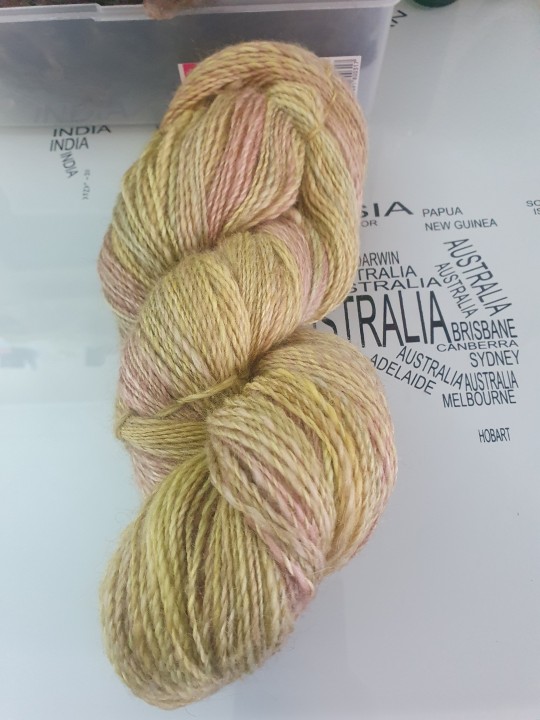
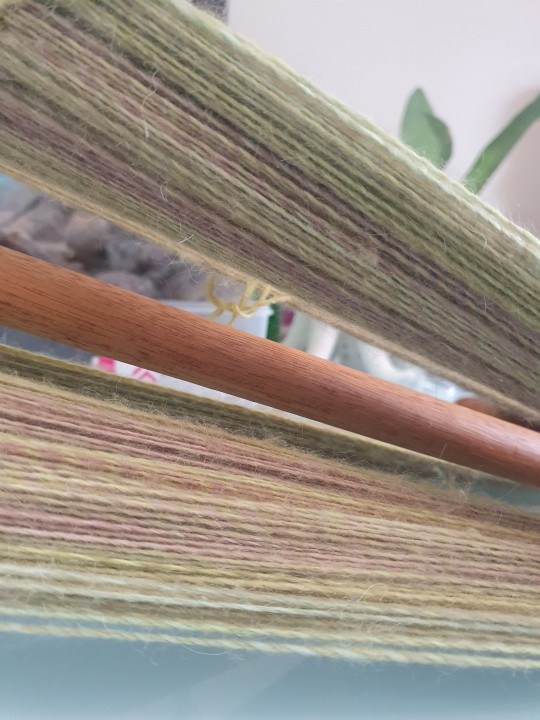
Baby camel/merino blend is done!
~100g and 400m, 2ply
Always feels good freeing up bobbins for other projects, this one was sitting as a half spun single for many months im so glad it's finished. I was really worried when plying with how the colours were lining up but it turned out beautiful.
Oh man it's so soft. Lowkey worried about the felting/pilling potential. Any recommendations for what I should do with it?
39 notes
·
View notes
Text
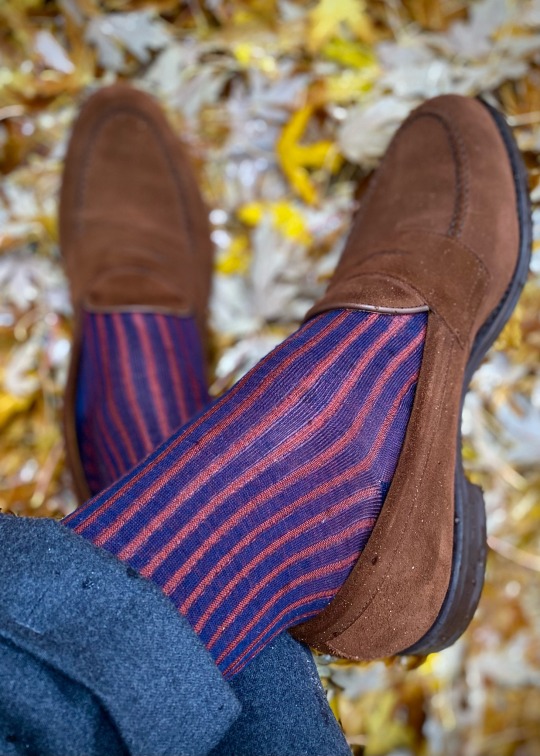
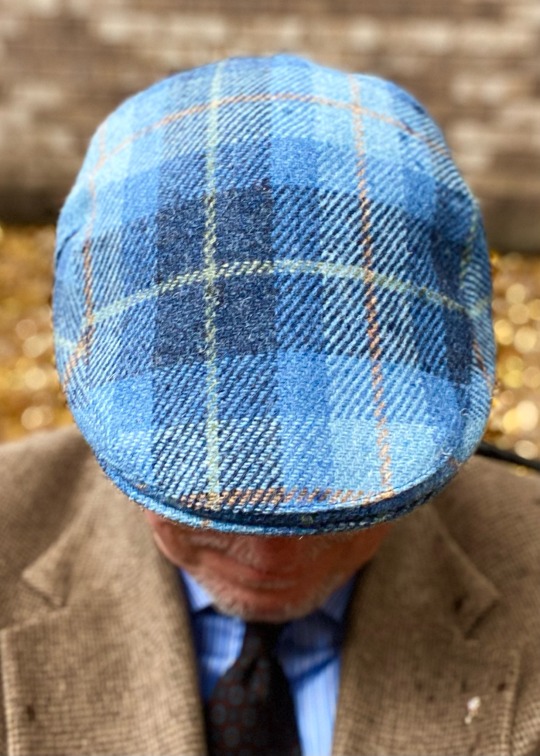
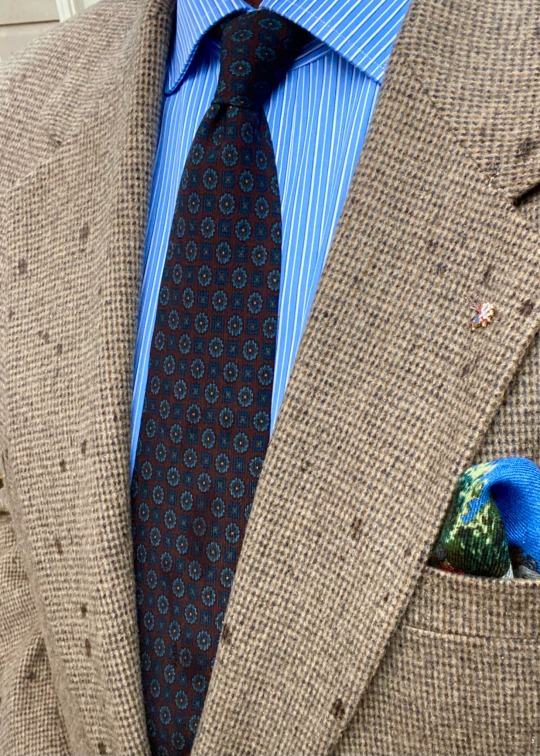
Browns & Blues…and Rain ☔️
#mature style#classic menswear#vintage style#classic style#sunday best#vintage#camel hair#wool challis#suede loafers#fox suede#fall#grey flannel#grey flannel trousers#celchuk socks#polobyralphlauren#berwick#EG Cappelli#utah#ivy hat#harris tweed#Jaxon and James
4 notes
·
View notes
Text

#men menswear formalwear mensweardaily dapper menfashion mensclothing gentleman businessman instafashion mensboutique luxurymen#not bristly#ideal for a regular knot#checked pattern camel brown background. @f.marino_napoli exclusive hand made in Italy for Wools Boutique Uomo Shop on woolsboutiqueuomo.co
5 notes
·
View notes
Text
Sourced from the resilient camels of arid regions, camel wool fabric offers natural warmth, breathability, and durability. Known for its soft texture and thermal insulation, it’s an ideal choice for winter wear and sustainable fashion. Valuexim Sources delivers premium-quality camel wool — ethically obtained and expertly processed to meet global textile standards.
#bulk flour suppliers#flour wholesalers#processed foods#wholesale dry fruits online#nuts wholesale#dried fruits wholesalers#dried fruits and nuts#camel wool fabric#camel wool products#blanket camel wool
0 notes
Text
goats, llamas, and camels should drop meat. they're farmed for meat in many parts of the world, mojang's continuous "ecological responsibility" excuse for making every mob convolutedly pointless doesn't hold up, literally the only reason to not let them drop meat is because they're not common livestock in western countries and that's what mojang bases all their ideas about what counts as a farm animal on
#minecraft#camels should drop leather and llamas should drop wool or string too#and you should be able to milk the goats#we are beyond overdue for more sources of food and basic og game mats
1 note
·
View note
Text
I really really really want to know if you can spin/weave/knit with that. They look so cute!
Interesting way to be introduced to the Bactrian camel (Camelus bactrianus). They’re ungulates native to the steppes of Central Asia. Distinguished from the dromedary camel by having two humps on its back instead of one. Domesticated around 5,000-6,000 years ago from a single wild population, distinct from the critically endangered wild Bactrian camels today.
1K notes
·
View notes
Text
Starting to remember one of the main reasons I largely stopped crocheting 20+ years ago... the pain of seeing so much pretty yarn that my wool allergy objects to. I'm not a big fan of synthetics but finding non-wool natural fibres in similarly pretty colourways and anything like actual wool textures is a major PITA. I'm sure I could buy at least some of the pretty hand-dyed yarn I keep seeing on Etsy and work it up into scarves and shawls and whatnot, but then I'd probably need to give them away since a lot of it I wouldn't be able to wear myself.
Finished that infinity scarf I've been working on; it came out okay but even at just 20% real wool fibres I could tell my allergies were noticing it whenever I worked on it, so that's probably going to be given away to someone else.
Currently have some skeins in my Etsy basket that I'm eyeing anyways - some silk-linen fingering that I want to try a skein of to judge whether I like it in person to make stuff for myself to wear, and a couple skeins of a lovely 100% SW merino fingering colourway that I might attempt making a shawl for my SIL out of. Though between the premium price for custom dyed yarn and then shipping those three skeins alone would be over $100, yikes. (Yeah that's another reason I haven't really crocheted in ages - the cost of yarn.)
#Fibre Crafts#Crochet#I have spent SO MUCH TIME the last few days salivating over yarns online#But all the colourways I loved most were only available on yarns with high wool content#I'm thinking of trying some of the less-usual yarn fibres just to test whether any set me off less#Like angora and camel and alpaca and so forth#Sadly the 'vegan' yarns seem thin on the ground and I'm suspicious of how many are supposedly bamboo#Because I 100% do not count rayon/viscose as a natural fibre#And I have my doubts over how much of that is actual naturally retted bamboo
1 note
·
View note
Text
Oxford Camel Wool Coat — Light Velvet

Indulge in luxury with the Oxford Camel Wool Coat from Welligogs. Featuring moleskin detailing on pockets, collars, and cuffs, this fitted coat is made from 100% soft wool. Mandarin collar and silver-effect buttons provide a striking contrast. A heavier wool, ideal for wearing with a fine jumper in the cooler seasons and a shirt in the warmer months.
Features:
100% soft wool
Contrast moleskin collar and pocket features
Fully lined
WG signature cuff feature
Beautiful muted brass buttons
Generous pockets
Stylish and luxuriously tailored
Fit: on the tighter side, if in between sizes we recommend going up
Visit for more options: Coats for Women
0 notes
Text
Here we go, fibre haul! You guys ready?

So all of these lovely bits of floof were purchased from The Fiber Imp.

The owner is so nice, I thought I'd give them a little shout out so you guys can buy any floof you like the look of here:
Most of the nerdy stuff I am sourcing my info from is a site called NWyarns.com which has great indepth info in the histories of many breeds of sheep and how they became the sheep we have today.
If I grab info from another website then I'll mention it specifically but otherwise this all comes from NWyarns.
Now let's dig in shall we?
First up, we have Rocky Mountain Skies
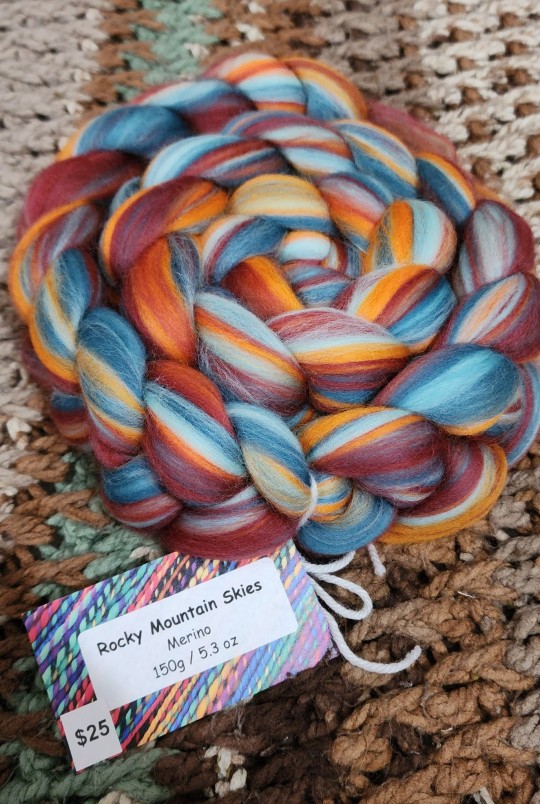
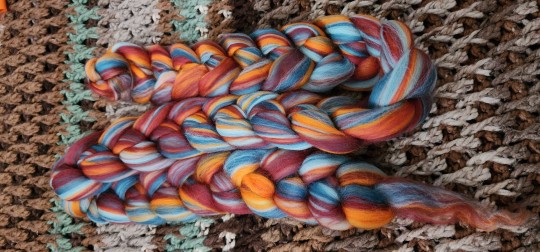
This one is commercially dyed and all 100% merino.
Domesticated in Mesopotamia sometime between 11,000 and 9,000 BCE
If you were not select royalty you were pretty much out of luck – there were no legitimate ways for the average sheep farmer to get a prized Merino ram or ewe until about the first decade into the 1800s. However, there were certainly illegitimate ways. Paying someone to smuggle Merino sheep out of Spain offered the chance of a prized ram or ewe. Certainly that is how the U.K. acquired their first Merino sheep (4 rams and 2 ewes), which Sir Robert Banks paid some enterprising business person to smuggle out of Spain via Portugal.
However, more often than not, it appears that the people purchasing Merinos through less than legitimate means during this time frame were either getting scammed or simply provided with any Spanish sheep that smugglers could manage to get out of Spain.
Merino is renowned for its fineness and elasticity, which can be made into woven, knitted, crocheted or felted wool fabrics that can be very comfortably worn directly against the skin. Merino is graded to a variety of micron widths including Superfine (17.6-18.5 microns), Fine or Extrafine (18.6-19.5 microns), Fine Medium (19.6-20.5 microns) and Medium (20.6-22.5 microns). Unless otherwise specified, you will find that most merino available in commercial clothing and most yarns is in the Fine Medium to Medium range. However, even though the Fine Medium and Medium Merino is the most common, it is by no means coarse! 22.5 microns is still quite fine, and extremely comfortable to wear directly against your skin.
Next up is Spellbound


75% 18.5 Micron Merino / 25% Mulberry Silk
This next bit of info comes from Casper.com:
Mulberry silk comes from the Morus Alba tree.
Originating in China over 5,000 years ago, “sericulture” is the ancient process of spinning silk.
Mulberry silk is made from the cocoon of the Bombyx mori moth. Before metamorphosis, the caterpillar feeds exclusively on the white mulberry leaf.
Smoother and stronger than any other silk in the world, mulberry silk is a textile powerhouse. Famous for its durability and lightweight quality, mulberry silk is able to retain up to a third of its weight in moisture. Because of this, it doesn’t emit a smell when damp and doesn’t need to be left out to dry for a long amount of time, making it relatively easy to manage.
Au Naturel
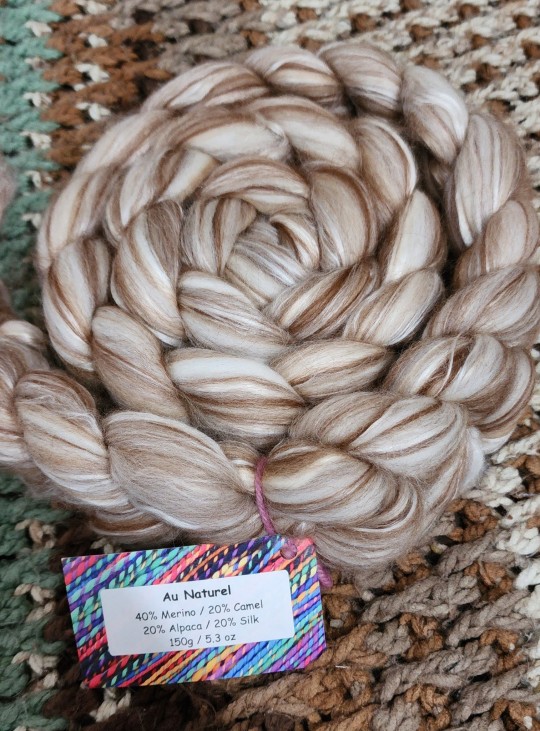
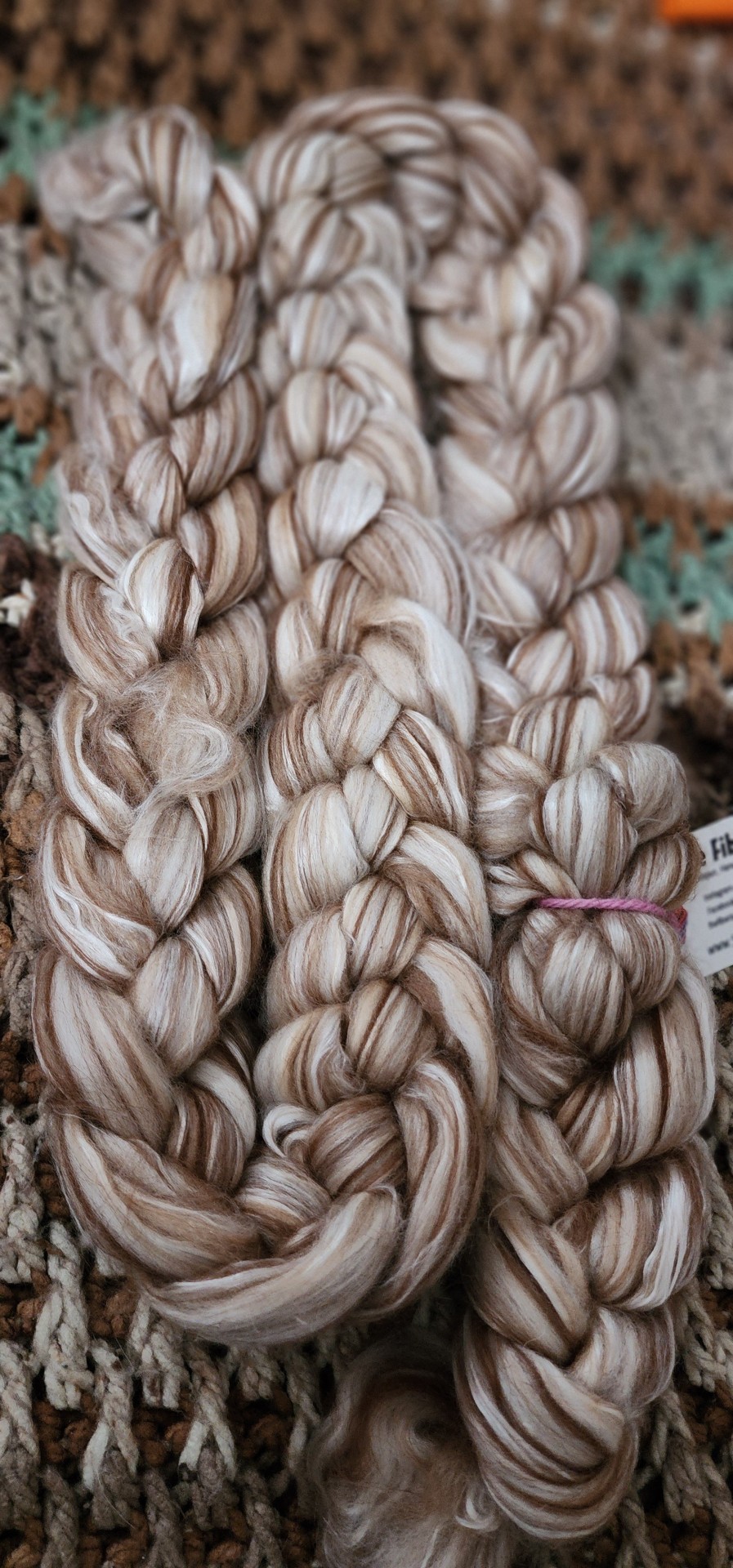
Undyed blend of superfine merino, dark brown alpaca, mulberry silk and baby camel.
Alpaca:
Alpacas are in the camelid family -- the same biological family as camels and llamas.
Although they can be found around the world today, alpacas originated in the Andes mountain range of South America. They are descended from vicuña, a wild camelid native to South America, in the Andes mountain range. The domestication of the alpaca for fiber and meat began up to 6000 years ago, with the people who lived in the Andes.
Alpaca hairs are hollow, making it a go-to fiber for crafters and manufacturers who are looking for softness with superior insulating properties. It is also surprisingly strong for such a soft, fluffy fiber.
Alpaca fiber comes in various qualities, ranging from fibers nearly as soft and luxurious as cashmere to lower quality fibers with a similar texture to fine wool. Most yarn and spinning fiber available relies on the high quality, fine alpaca. It is more difficult to find coarser alpaca, as there is little demand for it in North America. Alpaca is also hypoallergenic, making it very popular for people with skin sensitivities.
This next bit is from SpinoffMagazine regarding the Bactrian camel:
Bactrian camels have two humps and are found primarily in Mongolia and China.
Bactrians are the source for the soft down we associate with fine camel hair garments. Their fiber naturally sheds and can be combed away or gathered as it falls.
While the website for the Cashmere and Camel Hair Manufacturers states that Bactrian camels produce as much as 17 to 22 pounds of fiber annually, other sources cite amounts as low as 5 pounds. The higher amounts probably include both hair and down.
The outer coat and mane hair is long (12 inches or more) and coarse. It protects the animal from the elements, shedding dirt and water. The fine undercoat is much shorter, averaging 1 to 5 inches long, although it usually measures less than 3 inches in length. Some of the fiber shortness in commercial camel preparations may result from the dehairing process. The micron counts (fiber diameter) for camel fiber have a huge range. While the down averages 20 to 23 microns (similar to Merino wool), it can be as fine as the finest cashmere.
Samples from some United States Bactrian camel hair that had all the outer coat fibers removed ranged from 6 to 120 microns, with most of the sample measuring 18 to 19 microns. Camel hair has some crimp and a small amount of elasticity.
When working with the fiber in batt form (a cloud of carded fiber), I simply peel off thin layers of fiber.
Rovings (strands of carded fiber with a small amount of twist) and top (strands of long fibers in parallel arrangement) require no further preparation although they are sometimes easier to spin when split into narrower strips.
Because the camel fiber is short, thin strands of roving or top will probably drift apart if you try to predraft. You can also prepare for a lightweight yarn by handcarding the down fiber from any form into rolags.
This next bit of fibre is what pulled me into the shop in the first place, Dragon's Breath

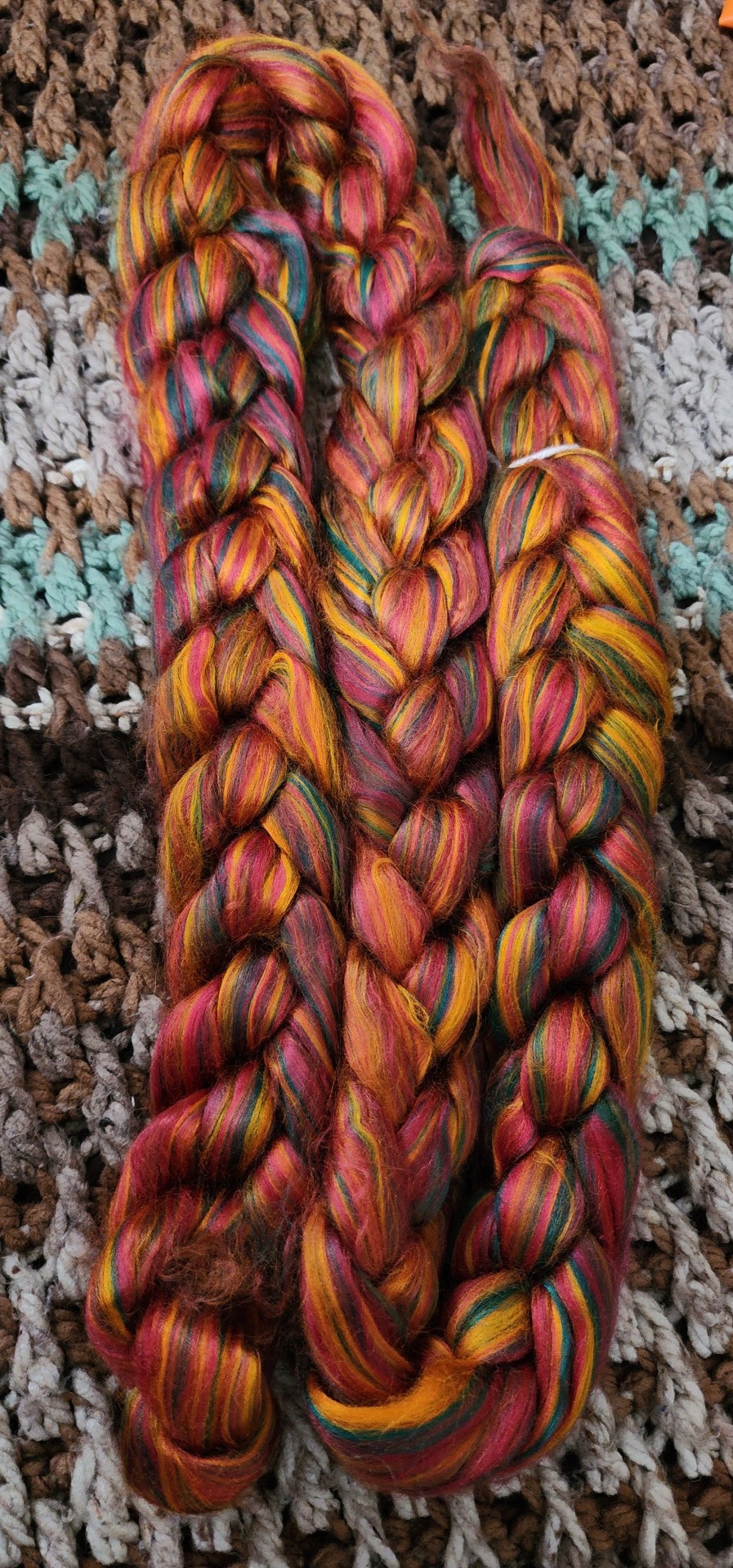
Bamboo:
In the late 19th century, the first semi-synthetic fiber in history was invented – viscose rayon! Known as artificial silk until its rebranding as rayon in 1924, rayon has become a significant part of our fiber landscape.
In the yarn and fiber world, we most frequently run into rayon when it is labeled as bamboo or viscose.
More recently, you can also buy viscose rayon labeled as rose fiber (having been sourced from the cellulose of rose bushes), or even purchase viscose rayon fiber that comes from seaweed.
While these fibers are often advertised as eco-friendly because they come from plants, that is not necessarily the case.
It has had a history of adverse health effects on the workers involved in its manufacture right up to the present day.
A short and somewhat abbreviated version of viscose rayon production goes something like this.
All rayon begins with pure cellulose. This cellulose is treated with a caustic soda, and goes through a number of curing processes and chemical treatments, including a process called Xanthanation in which it is mixed with carbon disulfide. The resulting material is dried and ground into a powder, and is dissolved in yet another caustic solution to form the viscose, the viscous solution from which viscose rayon receives its name. Allowed to stand for a period of time, the viscose solution is strained and then extruded through spinnerets, which land in a bath of sulfuric acid, forming rayon fiber. The fiber is then washed to remove any residual chemicals and make it safe for the wearer.
By the time rayon fiber and fabric hits the market, there are no traces of any chemicals that could harm the person wearing it. The same can’t necessarily be said for the factory workers, either in the past or today.
They go into more detail if you want to dig in further but I will need to research more myself before I commit to further bamboo purchases.
I will continue this in part 2!
#long post#wool#alpaca#camel#bamboo#fibre#show and tell#fiber#hand spinning#yarn#craftblr#part 1#haul
24 notes
·
View notes
Text

First Utah Snow…
#utah#mature style#classic menswear#classic style#vintage style#winter style#winter#brooksbrothers#William Crabtree#John Henric#silk#wool#camel hair#snow#greatest snow on earth#granqvist store
0 notes
Text
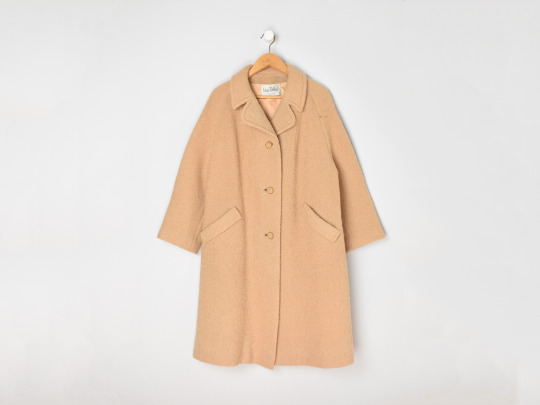
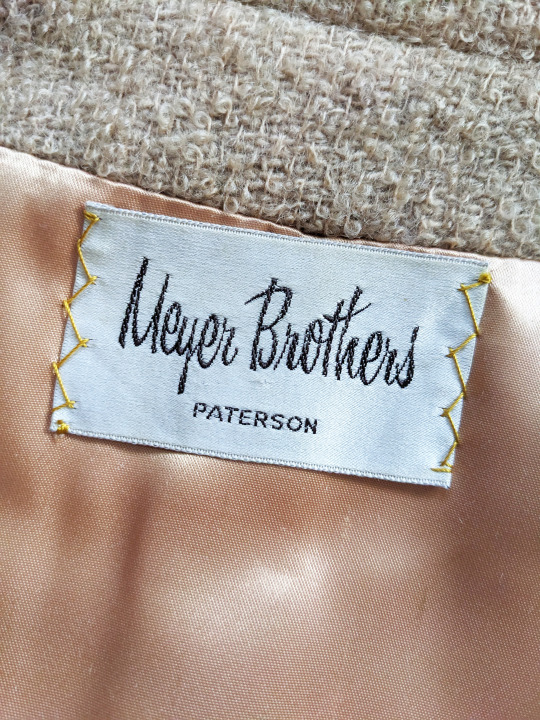


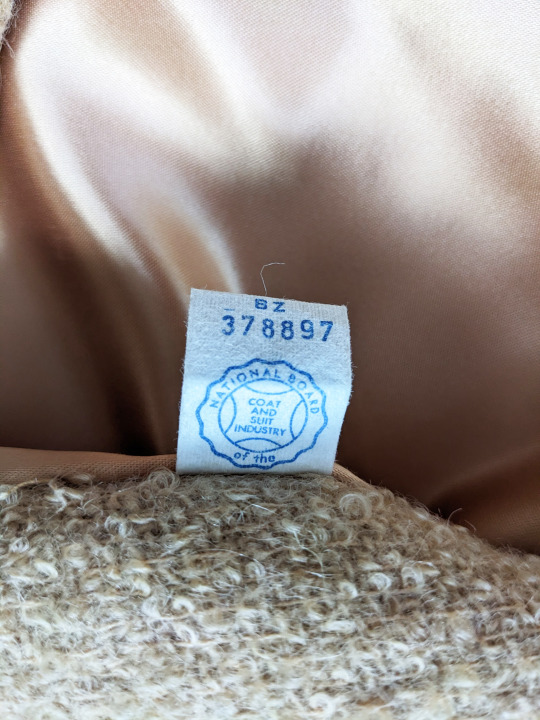
1950s Shagmoor Wool Coat
#vintage#clothing#vintage clothing#1950s#1950s fashion#1950s style#1950s vintage#camel coat#wool coat#beige#tan#labor unions#ilgwu#fall#autumn#wool#vintage coat#vintage wool coat#1950s coat
1 note
·
View note
Text

GG Wool Jacquard Cardigan in Black and Camel from Gucci ($1,800) & LV Groovy Platform Sneakers in Black from Louis Vuitton ($990)
#Natalya#Natalya wwe#nattie neidhart#GG Wool Jacquard Cardigan#cardigan#cardigans#black and camel#Gucci#LV Groovy Platform Sneakers#sneaker#sneakers#black#Louis Vuitton#women of wrestling fashion#wwe
0 notes
Text
Whether the intricate Madhubani paintings from Bihar or elegant Stone Handicrafts from Rajasthan, India’s rich heritage has a global fan base. However, bringing these treasures to international customers involves more than just great craftsmanship. One of the biggest challenges startups face is navigating international shipping services.
#Madhubani paintings#Stone Handicrafts#international shipping services.#bulk flour suppliers#flour wholesalers#processed foods#wholesale dry fruits online#nuts wholesale#dried fruits wholesalers#dried fruits and nuts#camel wool fabric#camel wool products
0 notes
Text
Making my tea with extra sugar in favour of Kuviren day :)
#unfortunately I do not own a wool blanket#I do have one that's stuffed with camel wool so.. I suppose that will have to suffice#kuviren
1 note
·
View note